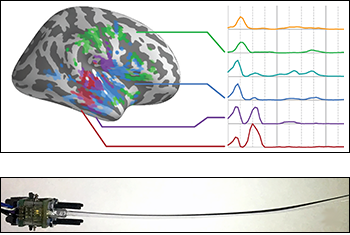Researchers part of two NSF Neural & Cognitive Systems grants worth more than $1.2 million
Faculty at the University of Maryland received two of 19 new research grants announced Aug. 8 by the National Science Foundation through its Integrative Strategies for Understanding Neural and Cognitive Systems (NCS) program. The grants are an indication of the university’s current and growing strengths in brain and behavior research, robotics and mechanical and electrical engineering. Maryland's portion of these grants is worth more than $1.2 million. Extracting Functional Cortical Network Dynamics at High Spatiotemporal Resolution Professor Jonathan Simon (ECE/Biology/ISR) and ISR-affiliated Assistant Professor Behtash Babadi (ECE) have received a $900,000 grant for research that will take advantage of recent technological advances in noninvasive neuroimaging to learn more about how the brain’s neural mechanisms work in adaptive auditory processing. Recent, growing evidence suggests that sophisticated brain functions happen when more than one region of the brain is activated at the same time, and the brain forms networks that dynamically reconfigure between these regions. These networks allow humans to rapidly adapt to changes in the environment. Currently, little is known about the workings of these networks that bind, organize, and give meaning to higher cognitive functions. Adaptive auditory processing is one such function. It the brain’s ability to attend to, segregate, and track one of many sound sources, to learn its identity, commit it to memory, robustly recognize it, and use it to make decisions. “Deciphering the neural mechanisms underlying the brain’s network dynamics is critical to understanding how the brain carries out universal cognitive processes such as attention, decision-making and learning,” notes Simon. “However, the sheer high-dimensionality of dynamic neuroimaging data, together with the complexity of these networks, has created serious challenges, in practice, in its data analysis, signal processing, and neural modeling.” The researchers will use modern signal processing techniques to combine high temporal resolution, non-invasive recordings with high spatial resolutions. “Our work will bring new insight as to the dynamic organization of cortical networks at unprecedented spatiotemporal resolutions, and can thereby impact technology in the areas of brain-computer interfacing and neuromorphic engineering,” says Babadi. “It will also allow for the creation of engineering solutions for early detection and monitoring of cognitive disorders involving auditory perception and attention.” Associate Professor Sarah Bergbreiter (ME/ISR) and two colleagues from Northwestern University, Professor L. Catherine Brinson and Professor Mitra Hartmann, were awarded a $1,000,000 grant to better understand how animals gather information through the sense of touch and then use this information to perform complex behaviors. At Maryland, Bergbreiter will be developing artificial, modular, reconfigurable whiskers that imitate the functions of animal whiskers. The University of Maryland’s portion of the grant is $320,000. The whiskers will be mounted on robotic platforms that can mimic the head movements of animals, contributing to the development of novel robots and sensors that use touch to sense an object’s location, shape, and texture, to track fluid wakes in water, and to sense the direction of airflow. “Engineering arrays of sensors to serve as physical models of a rat's whiskers will allow us to better understand the connections between what a rat senses and its actions,” Bergbreiter says. “Using this understanding, we can design robots with the ability to explore dark areas or work in other challenging environments that require a sense of touch or flow.” About the NSF Neural and Cognitive Science Program These NSF awards have been issued to U.S. cross-disciplinary teams to conduct innovative research focused on neural and cognitive systems. The awards contribute to NSF’s investments in fundamental brain research, in particular support of Understanding the Brain and the BRAIN Initiative, a coordinated research effort that seeks to accelerate the development of new neurotechnologies. "It takes insight and courage to tackle these problems," said Ken Whang, NSF program director in the Computer and Information Science and Engineering Directorate (CISE). "These teams are combining their expertise to try to forge new paths forward on some of the most complex and important challenges of understanding the brain. They are posing problems in new ways, taking intellectual and technical risks that have huge potential payoff."
Related Articles: August 10, 2017 Prev Next |


